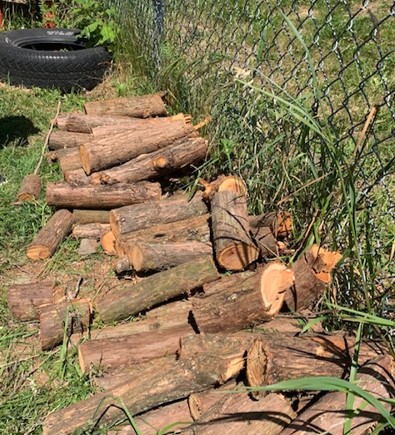By Jill Adshead
Play is the highest form of research.
Albert Einstein

A pile of sawed off tree branches that were recently cut from a tree in the backyard.
Untouched, neatly stacked against the metal fence. The children walked by them but yet, no one showed interest.



I called over to J. “J, please come here. I have something to show you.” J ran over and looked at me standing directly in front of the logs.
“Want to build something out of these logs?” I asked. In a high-pitched voice, J excitedly said, ”Yeah!”
I asked him where we could put them. He scanned the area and focused on the tires. “There,” he pointed.
J, “I need you to help me build a track.” “Sounds like a great idea!” I answered. J’s friend R was nearby. I suggested to J that he include R in this build. J did so and they both eagerly took charge while I slipped into the background.
J, “We need them to go like that.” J and R began to line up the logs in a straight line. I found this interesting as I assumed the children would build a campfire because of the size of the logs.
J, “We need them to jump over these.” J points from from one end of the logs to the other while holding a matchbox car in the other.
R, “I want a tunnel.”
J, “Look! There’s two jumps!”
The boys continue with their build.

J, “I have an idea.” He doesn’t finish his thought but with a long sigh, “It won’t work though.”
J and R don’t conversate but are focused on their own project within their project.
R, “There’s an ant on it.” J goes to R, “Oh yeah, I see it.” R tries to catch it. J, “It’s black. The red ones are bad.”
I questioned, “What do red ants do?” J, “They bite you.”
J continues to build and R leaves the space. J does not ask him where he was going.
J, “This is going to be a carwash. It’s going to go fast, jump, jump and over to the other side.”


J asks if I could fill a watering can for him and I do.
J, “Thanks.”
J slowly pours the water over the car. He proceeds to get the car dirty in the dirt and washes it off with water. This is action is repeated.
J stands up, leaving his car and water on the ground. With his left hand on his chin, “This is what I do when I am thinking.” He walks in circles. J, “I’m thinking. This is what I do when I think.” With his left hand he taps his chin.
He walks back to his car and watering can. “Wash, rinse, rinse, dry.”
He continues, “How do we dry it off?”

At this point in time, I could have given a multitude of answers, but I wait. I say, “Great question! How do we dry it off?”
J stands up again with his left hand on his chin and walks in circles. “In the sun!” he exclaims.
He walks over and leaves the car on a wooden table to dry out in the sun.
J, “40 minutes to dry out in the sun. It will be done drying when we are done the track.”
Lingering questions
- How do I engage with children? When might I step in and when might I step back?
- “What kinds of questions do I ask about children’s engagements? How does my language reflect children as creators of theories? How do my questions reflect children as constructors of knowledge?” (ELF, p. 76)
- How could this play be extended? “What materials invite experimentation, problem solving, or intrigue?” (ELF, p. 77)
- What are the complexities of being an educator and researcher? What am I listening to? What matters to me? And what do I make visible in documentation?
- How are children involved in the process of working with documentation? What are some ways children can give permission to share the stories? Where do the stories live?
Reference:
Government of British Columbia. (2019). British Columbia early learning framework (2nd ed.). Victoria: Ministry of Education, Ministry of Health, Ministry of Children and Family Development, & British Columbia Early Learning Advisory Group. https://www2.gov.bc.ca/gov/content/education-training/early-learning/teach/early-learning-framework
